Adata XPG Dazzle 16GB DDR4-2800 Dual-Channel Memory Kit Review
Dazzle LEDs add light effects to Adata’s XPG memory, but what is the price of bling? We compare its DDR4-2800 16GB kit to some unlit rivals to see if it’s still a reasonable bargain.
Why you can trust Tom's Hardware
Test Results And Final Analysis
Gigabyte’s Z170X-Gaming G1 set the high mark for DDR4 overclocking in our Z170 review series, and will remain the motherboard of choice until a new, superior-overclocking model is found. I’ve also retained our previous-generation benchmark hardware and software, which will be updated whenever a suitable replacement motherboard is found.
Test System Configuration
| Sound | Integrated HD Audio |
|---|---|
| Network | Integrated Gigabit Networking |
| Benchmark Configuration | |
| Autodesk 3ds Max 2013 | Version 15.0 x64: Space Flyby Mentalray, 248 Frames, 1440x1080 |
| WinRAR | Version 5.0: THG-Workload (1.3 GB) to RAR, command line switches "winrar a -r -m3" |
| Grid 2 | Steam Version, In-Game Test, High Quality, No AA |
| Battlefield 4 | DirectX 11, 100-sec. Fraps "Tashgar", High Quality |
| SiSoftware Sandra | Version 2014.02.20.10, Memory Bandwidth, Cache & Memory Latency Benchmarks |
Far from a stellar overclocker, Adata’s 16GB XPG Dazzle DDR4-2800 kit only reached a maximum data rate of DDR4-3036, even after increasing DIMM voltage from the specified 1.25V DDR4-2800 value to custom 1.35V settings.
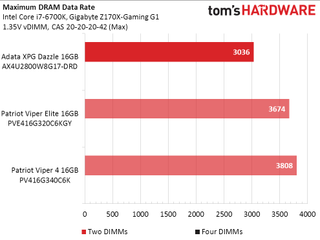
Since XPG Dazzle 2800 never reached DDR4-3200, I wasn’t able to use that setting for its analysis. It reached good DDR4-2133 timings, and its DDR4-2666 CAS 13 timings are nearly as quick as the old DDR3-1600 CAS 8 performance standard.
| Lowest Stable Timings at 1.35V (Max) on Gigabyte Z170X-Gaming G1 (BIOS F5i) | |||
|---|---|---|---|
| DDR4-3200 | DDR4-2666 | DDR4-2133 | |
| Adata XPG Dazzle 16GB AX4U2800W8G17-DRD | Not Capable | 13-14-14-28 (1T) | 11-11-11-28 (1T) |
| Patriot Viper Elite 16GB PVE416G320C6KGY | 15-15-15-30 (1T) | 12-12-12-28 (1T) | 10-10-10-28 (1T) |
| Patriot Viper 4 16GB PV416G340C6K | 16-16-16-32 (1T) | 13-13-13-28 (1T) | 11-11-11-28 (1T) |
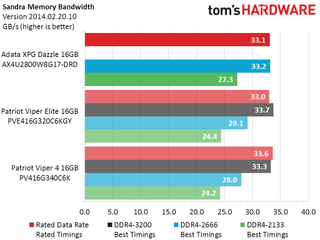
Sandra Memory Bandwidth shows better than expected performance for Adata’s XPG Dazzle DDR4-2800, edging out Viper Elite DDR4-3200 at XMP settings. Adata is likely specifying slightly tighter secondary and tertiary timings, and that could also explain why it overclocks so poorly.

Poor primary timings still put a big hurt on Adata’s XPG Dazzle DDR4-2800 in Sandra Memory Latency, however, and it’s going to be great to see how its mixed Sandra performance impacts a few of our memory-sensitive applications.
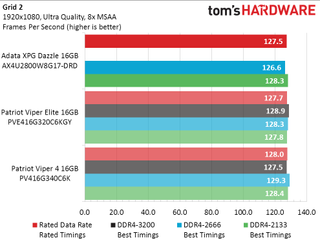
Grid 2 become memory sensitive at any setting low enough to free up graphics resources, but those settings generally produced hundreds of FPS. Readers have argued that nobody really cares about hundreds of FPS, so I compromised by looking for a setting that actually affects other hardware, such at 120 Hz displays. Unfortunately, using a setting that barely plays smoothly on a 120 Hz display turns the graphics card into the weakest link, minimizing differences due to memory.
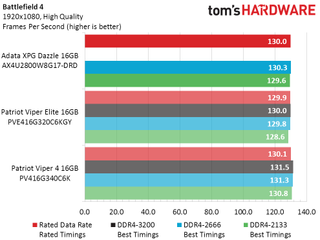
Battlefield 4 is slightly less sensitive to DRAM settings than Grid 2, and once again choosing a quality setting that’s barely adequate for a 120 Hz 1080p display overwhelmingly shifts the load limit to the GPU.
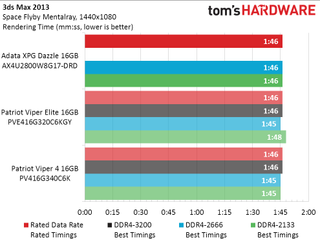
Even 3ds Max was once limited by RAM, but has more recently been limited by other factors as memory has gotten slightly better. It still needs a certain quantity of memory to function optimally, but we left that problem in the rear view mirror way back when we started testing 8GB kits.

WinRAR is affected by CPU, storage, and DRAM performance. Though one-second differences can usually be disregarded due to rounding up or down result inconsistencies of a few thousandths of a second, we do see a two second difference between the worst and best run times. Surprisingly, the slower-rated Adata memory is not the lowest in this bout.

Overall, XPG Dazzle provides more performance-per-dollar thanks to its lower cost, and this is in spite of the slight added cost of its LED lighting. At around $115, the price has been so good that it even ties Patriot’s Viper Elite DDR4-3200 in overclocking value, in spite of the wide disparity in overclocking capability. Unfortunately, these appear to be in short supply as Adata is attempting to fill the market for an even more value-priced, 32GB version of the kit.
The XPG Dazzle DDR4 3000 supersedes the DDR4 2800, and while it is listed at $135 at the time we’re pushing this review live, it also was listed at $115 merely one week ago. At the right price, consider either the DDR4 3000 (2x 8GB) or the 32GB modules, which provide 100% more capacity for 40% more in cost.
MORE: Best Memory
MORE: DDR DRAM FAQs And Troubleshooting Guide
MORE: All Memory Content
Stay on the Cutting Edge
Join the experts who read Tom's Hardware for the inside track on enthusiast PC tech news — and have for over 25 years. We'll send breaking news and in-depth reviews of CPUs, GPUs, AI, maker hardware and more straight to your inbox.
-
lola213 Is Adata going out of business soon or something? I was trying buy RAM from them but it seems I cant find the model I want and I kept hearing that they wont have it.Reply -
JamesSneed Bedazzled RAM isn't that cute. The year of the lets slap LED's on stuff and make it shiny continues.Reply -
SCANNERMAN777 Another company struggling to stay afloat in troubled times. But let's be fair. ADATA has made some pretty tough stuff in the past and what most memory companies won't tell you is they get all get most of their chips from the same place. So whether it's Kingston, Hynix, or Adata it really doesn't matter much now does it? ADATA made the right move going to 16Gb because we will be seeing a lot more of this thing in the future. The demand for "extensive" memory is on the upswing.Reply -
Crashman Reply
I couldn't help but think the word "medazolam" every time I wrote the product name :D19008249 said:Bedazzled RAM isn't that cute. The year of the lets slap LED's on stuff and make it shiny continues.
-
Olle P Isn't it supposed to default at 2,800MHz? (At least with XMP enabled.) Why running it at 2,666MHz and not mention 2,800?Reply -
Crashman Reply
Do you see where it says "Rated Data Rate Rated Timings"? Those results use the XMP settings for each module set.19011180 said:Isn't it supposed to default at 2,800MHz? (At least with XMP enabled.) Why running it at 2,666MHz and not mention 2,800? -
PCDesignerR Well I can't knock it. It seems like a cool idea as long as no performance is sacrificed for the sake of getting the RAM that has the cool LED on top.Reply

